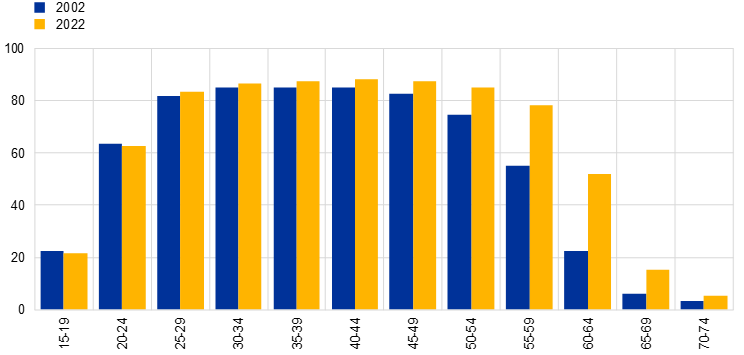- THE ECB BLOG
Record labour participation: workforce gets older, better educated and more female
8 November 2023
More people than ever are in a job or are looking for one – labour force participation in the euro area is at an all-time high. This week, The ECB Blog looks at who the new workers are and discusses changes in labour force demographics over the last two decades.
The euro area labour market is in pretty good shape despite the recent economic shocks. The share of people in the labour force has never been higher. Who are these new workers? We find that the labour force has changed quite a bit in terms of gender, age, education level and national origin over the last two decades.
But first, let’s look at more recent developments. When the pandemic hit, millions of workers lost their jobs. More than six million were discouraged or decided to leave the labour market for other reasons. This led to a 2.5 percentage point drop in the labour force participation rate (LFPR).[1] In the summer of 2020 only 62.1% of the population aged from 15 to 74 had a job or was looking for one. This compares to 64.6% before the pandemic broke out in early 2020.
This gloomy situation didn’t last long. The euro area economy recovered quickly, thanks in part to widespread policy support measures such as job retention schemes. Many people came back to the labour market, which brought the participation rate back to pre-pandemic levels as early as the fourth quarter of 2021. A year and a half later, in the second quarter of 2023, the participation rate hit 65.5%, 0.9 percentage points above its pre-pandemic peak. At that point in time around 3.8 million new workers were attached to the labour market. Nevertheless, participation rates in the United States (69%) and United Kingdom (68%) suggest that there is still scope for further increases.
Before and after the pandemic: who joined the labour force
What drove the changes in the labour participation rate in the euro area? We focus on gender, age, education level and nationality groups in Chart 1. Comparing the quarter before the pandemic outbreak to mid-2023, we first consider the increases in the LFPR for each group (yellow bars). Second, we examine composition effects, noted by changes in the relative size of each group in the working age population (red bars). For example, as the population grew older, the share made up of workers aged 25 to 54 shrank, and the share made up of older workers increased. This means that even though more workers aged 25 to 54 entered the labour market, their overall contribution to the LFPR was negative as their share of the population faded. The overall negative contribution by this group of workers is represented in the age category of Chart 1 by the blue bar.
Chart 1
Contributions to the change in the LFPR between Q4 2019 and Q2 2023
Percentages

Source: Eurostat, European Union Labour Force Survey (EU LFS), Integrated Economic and Social Statistics, and authors calculations.
Since the fourth quarter of 2019, women, older workers aged 55 to 74, highly educated persons[2], and immigrants have contributed most to the increase in the euro-area LFPR. Women mainly increased their participation rate, while other socio-demographic groups increased both their participation in the labour market and their relative size in the working age population. Men, younger workers aged 15 to 24 and natives also contributed positively, but to a lesser extent.
People are retiring later
The euro area population aged significantly over the last decades. The average age was 42.9 years in 2002 and 45.2 years in 2022. With the ageing of the baby boomer generation, older workers became more prominent in the working age population, with their relative share gradually increasing from 27.1% in 2002 to 33.8% in 2022. The ageing of the working population has offset increases in the LFPR. In fact, the LFPR would be 1.6 percentage points higher in 2023 if not for the effects of population ageing (see Chart 2). This is on account of older workers displaying a lower labour market attachment than workers aged 25 to 54.
Chart 2
Impact of ageing on the euro area LFPR over time
Percentage

Source: Eurostat, European Union Labour Force Survey (EU LFS), Integrated Economic and Social Statistics, and authors calculations. The age-adjusted labour force participation rate keeps the working age population shares constant by age groups as they were in 1997.
At the same time, older workers have become significantly more attached to the labour force, in part due to pension reforms and increased life expectancy (see Chart 3). The participation of workers aged 25 to 59 is considerably higher than that of both the younger and older cohorts. We note a very large increase in the participation rate of workers aged 50 to 64 over the last two decades, which compensated the downward impact of population ageing.
Chart 3
Euro-area LFPR by age
Percentage

Source: Eurostat, European Union Labour Force Survey (EU LFS), Integrated Economic and Social Statistics, and authors’ calculations.
More women working or on the job market
Women have substantially increased their attachment to the labour market in recent decades. Their LFPR increased from 48.1% in 1997 to 60.8% in the beginning of 2023. At the same time, the LFPR of men has been broadly stable between 68% and 70% since 1997. This is in part thanks to policy measures aimed at increasing female employment, which include subsidised childcare services for working parents with small children, tax changes and improved leave policies.
Euro-area workers tend to be more educated over time, with the share of workers with an undergraduate degree or higher increased from 22% in 2002 to 37% in 2022. And higher levels of education tend to lead to higher levels of participation in the labour market, including in the euro area. Around 80% of people with an undergraduate degree or higher are active in the labour market, which compares to less than 50% among persons that have not finished a secondary school degree or similar. As the proportion of more highly educated workers in the labour force increases, participation rates tend to mechanically increase.
Workers move across borders for new jobs
Migration, too, supports an increase in labour supply in the euro area. The share of foreign workers in the working population has risen steadily, from 6.9% in 2005 to 11.5% in 2023. 60% of these immigrant workers come from non-EU countries. Labour mobility within the EU also helped increase labour participation rates. EU citizens often move across euro-area countries for work-related reasons. In fact, the LFPR for immigrants from within the EU increased from 68.8% in 2005 to 74.7% in the second quarter of 2023.[3]
The LFPR’s rise above pre-pandemic levels indicates a growing supply of workers. Older, female, highly educated and foreign workers are still the main contributors to the rise in the LFPR. Both historical trends and comparisons to other jurisdictions suggest that women and older workers will continue to drive future increases.[4] Population ageing will of course continue to reduce the LFPR, as workers simply become too old to work. But the overall trend of a growing workforce remains. This should have a mitigating effect on the tightness of the labour market over the longer term.[5]
Check out The ECB Blog and subscribe for future posts.
The views expressed in each article are those of the authors and do not necessarily represent the views of the European Central Bank and the Eurosystem.
The labour force participation rate is the share of persons in the population aged from 15 to 74 who are working or actively searching for a job.
Low-educated persons have a less than primary, primary, and lower secondary education level, medium-educated persons have an upper secondary and post-secondary non-tertiary education level and high-educated persons have a tertiary education level.
For comparison, the LFPR for nationals stood at 65.3% in the second quarter of 2023, while the LFPR for immigrants from outside the EU has remained stable at around 64%.
The labour force participation rate for women aged from 15 to 74 in the US stood at 63.1% in the second quarter of 2023, slightly higher than for the euro area. For the US, the labour force participation of working-age women reached its historical peak at around 65% at the turn of the millennium, and progressively decreased until it reached 62.8% in the first quarter of 2020. The US labour force participation for women aged from 15 to 74 plunged to 60.5% during the pandemic and is now progressively recovering, surpassing its pre-pandemic levels in the second quarter of 2023.
Another channel to be considered is the rise of remote working. This provided the opportunity to work without the need to commute and, in this way, incentivised these persons to be more active in the labour market. Recent data from the ECB Consumer Expectations Survey (CES) points to a decline in the number of discouraged workers and to a rebound in the labour force participation rate following the pandemic. In particular, the box article titled “The labour market recovery in the euro area through the lens of the ECB Consumer Expectations Survey”, ECB Economic Bulletin, Issue 2/2022, notes that the increase in the participation rate has in part been the result of transitions of respondents who were not actively searching for work directly into employment. The recovery in the labour force participation rate following the onset of the pandemic might also have been affected by a structural shift in preferences on work from home (WFH) patterns. In a recent box article titled “How people want to work – preferences for remote work after the pandemic”, it is noted that, while both employers and workers are still adapting to the changing WFH patterns, it appears likely that remote work will remain in substantially higher demand than before the onset of the pandemic. Regarding health-related labour market discouragement from the pandemic, another box, “COVID-19 and retirement decisions of older workers in the euro area”, showed that older workers who displayed a poorer state of health were more likely to retire early.




